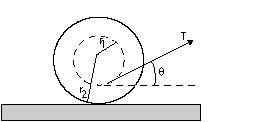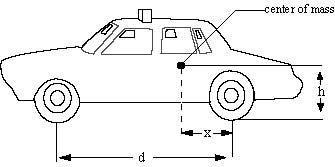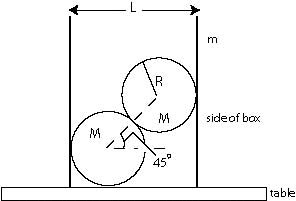Physics 105 Problem Set 5
Due: Thursday, October 18, 2007, by 4:30 pm in 208 Jadwin.
Reading
K&K 6.1-6.7
It is a very good idea to do the 103 Learning Guides 5 and 6. The
problems that you turn in do not cover all of the material for
which you are responsible!
Problems to turn in
Problem 5.1
-
A solid cylinder of mass m, radius R, and thickness (width) l
is released from rest and rolls without slipping down a plane inclined
at an angle theta to the horizontal.
(a) Draw a free body diagram and compute forces and torques to
determine the angular acceleration and linear acceleration
down the plane.
(b) Compute the kinetic energy of a rolling-without-slipping
cylinder as a function of linear speed and compare with the gravitational
potential energy to determine the linear acceleration down the plane. If you
answer does not agree with part (a), explain.
(c) Now consider a 4-wheeled cart of total mass M with four
wheels, each with radius r and moment of inertia I. Ignore
friction in the axles or bearings. What is the acceleration a?
What is the implication for a race on Hot Wheels track?
(If you don't know what Hot Wheels are, ask one of your instructors!)
What is the limit as I becomes small?
To what is I being compared when it is said to be small?
Problem 5.2
-
A spool rests on a rough
horizontal table. A massless thread would on the spool is pulled with
force T at an angle theta to the horizontal.
 (a) If theta=0, will the spool move to the left or to the right?
(b) Show that there is a critical angle, theta_0, for which the spool
remains at rest. Assume that T is small enough so that the spool does not
slip.
(c) At this critical angle, theta_0, find the maximum tension for
equilibrium to be maintained. Assume a coefficient of static friction
of mu_s.
(a) If theta=0, will the spool move to the left or to the right?
(b) Show that there is a critical angle, theta_0, for which the spool
remains at rest. Assume that T is small enough so that the spool does not
slip.
(c) At this critical angle, theta_0, find the maximum tension for
equilibrium to be maintained. Assume a coefficient of static friction
of mu_s.
Problem 5.3
-
K&K 6.8.
Problem 5.4
-
The center of mass of a car of mass M is a distance h above the surface
of the road and a distance d-x behind the front wheels. The front and
rear wheels are a distance d apart (d>x).
(a) If the car is at rest, find the normal forces exerted by the
road on the two front and the two rear wheels, N_f and N_r
respectively.
(b) What is the fastest the car can accelerate (that is, the maximum
acceleration) before the front wheels leave the road? (Hint: consider
dL/dt.)
Note: neglect the angular momentum of the rotating tires. Assume that the
suspension keeps the axles fixed to the frame of the car. You may assume
that the car has 4- wheel drive, though you will find that it doesn't matter.

Problem 5.5
-
Two steel balls, each of
radius R and mass M, are packed into a bottomless cylindrical
thin-walled tube of diameter L =[2+sqrt(2)]R. The tube and balls sit
on a table. There is no friction anywhere in the problem. Find the
minimum mass of the tube m that will keep the system in
equilibrium.



